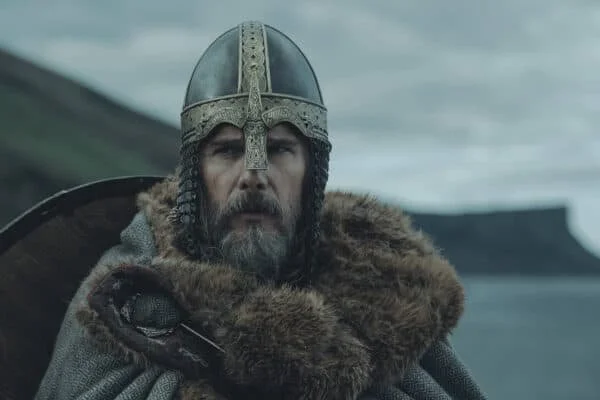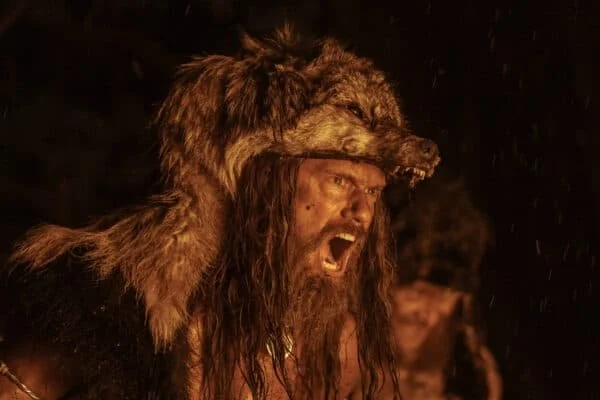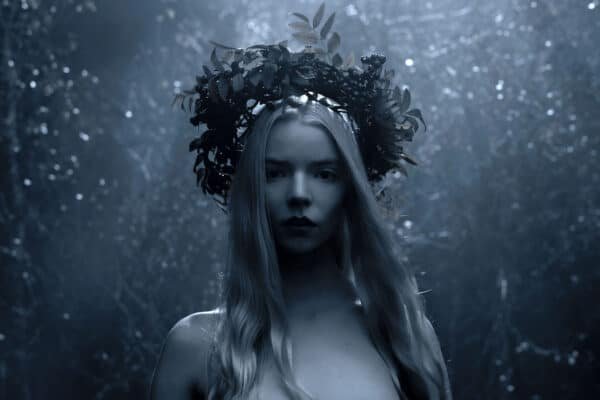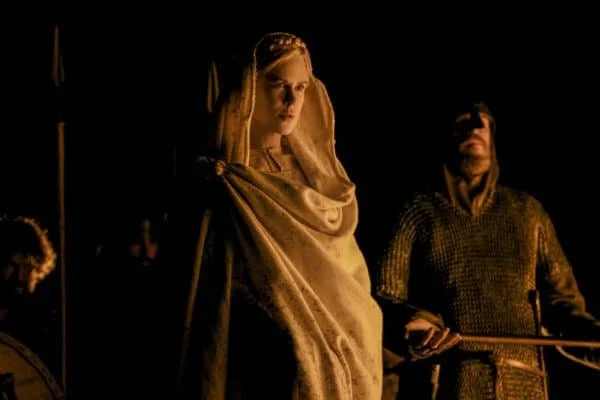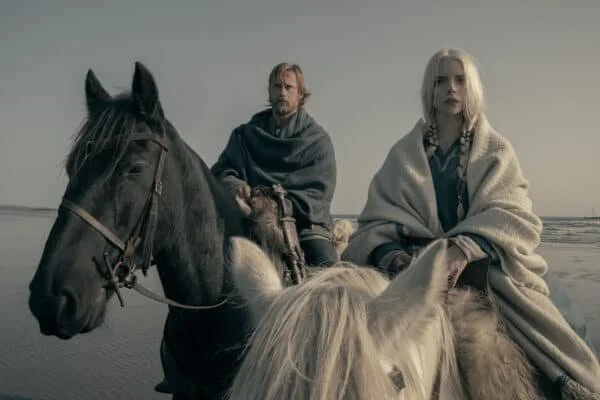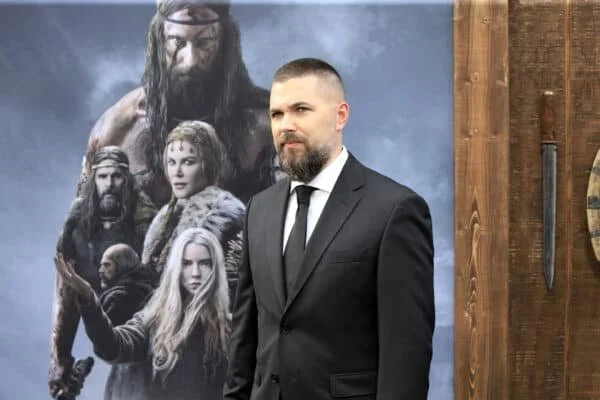The Northman: Our Roots, Evils and All
(GREGORY HOOD) You’ve probably seen headlines like “White Supremacists Love The Northman.” The Guardian, The Daily Mail, Paste Magazine and The Mary Sue have used them as clickbait.
Of course, director Robert Eggers had no pro-white intensions when he made the movie, claiming instead that he aimed to take Nordic culture back from “Nazis:” “Nazi misappropriation of Viking culture cemented my disinterest as an adult.”
His waffling doesn’t matter. Mr. Eggers is one of the best filmmakers alive. The Witch and The Lighthouse raise fundamental questions about the nature of reality. We’re never quite sure what’s happening. At a time when people seem to be living in entirely different realities based on where they get their news, these films hit deep. They suggest there’s more to life than public relations. There could be something supernatural.
With The Northman, Mr. Eggers takes us back to a sacralized world, where the gods are ever-present, fate is set, and glory awaits the strong. It is subversive just to suggest there’s an alternative to modernity, even if that alternative is frightening. That’s why some critics don’t like this movie.
The film is visually stunning, with lingering shots of vast glaciers and idyllic countryside. While it’s set in Iceland, only some of the filming took place there; the majority was in Northern Ireland.
In pleasant contrast to the recent crop of clichéd Viking movies and television series, Mr. Eggers strove for historic accuracy, consulting scholars such as Neil Price to portray the Norse as authentically possible, down to their villages, costumes, and views of life.
The Northman isn’t a “pro-white” movie that glorifies Vikings. All atrocities are done by whites to whites. Perhaps that is enough for a movie to be politically incorrect. It is a scandalously all-white movie, with no artificial “diversity.” The leftists were right: The personal is political.
Our great myths, stories, poems, and plays, don’t belong only to “whites” but to the world. True to our Faustian spirit, our culture explores the human condition without limits. Unless it were done to desecrate, there’s nothing wrong when Asian musicians play Beethoven, or an African drama group puts on Julius Caesar. The emotions are universal. Of course, it’s jarring when non-whites play white historical characters.
The Northman is a retelling of Hamlet. It is the story of Amleth — a hero from Saxo Grammaticus’s history of the Danes. There is a prince disinherited by a murderous uncle, who slays prince’s father, steals the kingdom, and makes the mother his wife. There’s the hero’s strategy of pretending to be something he’s not, in order to get revenge. There’s a woman who complicates his quest.
Shakespeare’s Hamlet is a universal and modern man, aside from his religious beliefs. He sees both the infinite potential and poisonous corruption within our species, from godhood to “quintessence of dust.” He muses on nihilism, suicide, cowardice, and purpose — something especially remarkable given his deep belief in God. He’s paralyzed by intellect. He’s the modern West.
The Northman gives us the deeper roots of European man. If white advocates want to see a movie glorifying our race, they won’t find it here. The Vikings in the story are torturers, rapists, and enslavers. Perhaps some critics may not like the movie because it shows that whites can be victims, even slaves. History isn’t a continuous story of whites cruelly ruling the world.
In one scene, Vikings lock women and children in a building and burn them alive, something none of the warriors protest or even really notice. “We did good,” says one. It’s impossible not to think the word “good” was inserted simply to show this alien morality. What we’re seeing can’t be “good.”
However, even in its cruelty, Amleth’s worldview, something so intertwined with his nature that it’s unshakable, saves him from indecision. There is no wondering about morality, no rumination on man’s place in the world, no need to prove his uncle’s guilt to others. Initiated by his father into a royal cult, he learns always to live “with honor,” which means always putting vengeance first and protecting one’s bloodline. He lives with the reality of fate. Fate is something to be discovered, not invented. “Your fate is set and you cannot ‘scape it,” say two prophets in the film. Contrary to the film’s promotional material, which included the line “Conquer your fate,” Amleth fulfills it.
But if we have a set fate, are we free? Broadly speaking, pagan northerners would answer that fate is set but there’s still choice. You can try to flee fate, but it will drag you back. If you don’t abide by the honor-based morality of vengeance, you will live in shame and disgrace. There is no equality, even of souls. The warrior seeks what Julius Evola would call a mors triumphalis, in which heroic action leads to complete totality, when becoming is being. In mythic terms, he goes to Valhalla as one of the High One’s chosen, blessed to fight until the end of time.
What of the white slaves? They are chattel, unworthy of consideration. Amidst a terrible scene of slaughtering innocents and wholesale destruction, one Viking lightly mentions that these “savages” make fine slaves. Acting like ravening beasts is not “savage,” but these terrified women and children, some beautifully dressed, are. Despite this, one can’t help admiring an honor-based system compared to the victimhood-based system of today.
By digressing from Hamlet and even the written legend of Amleth, Mr. Eggers forces us into an alien mentality. This movie does what few others can by gradually getting us to accept scenes of magic and irrationality. It is neither an action movie nor a play. It is a saga, complete with the exaggerations, crude humor, and acceptance of magic and gods directly intervening in human affairs. Hamlet may have seen his father’s shade, but Amleth gets direct help from Odin.
In this story, Amleth’s father, King Aurvandil War-Raven, returns home to the joy of his son. The king seems secure. His settlement is orderly and well defended. His people greet him with respect. His warriors cheer him and he brings home treasure, including a necklace that belonged to another prince. This means the War-Raven ruined a kingdom much like his and probably murdered a prince just like his son. In his world, this is cause for celebration.
King Aurvandil (Credit Image: © Focus Features / Entertainment Pictures / ZUMAPRESS.com)
His brother Fjölnir enters and the king greets him with gratitude. However, Fjölnir enters with black dogs, a hint of animal rage. Heimir, the fool, jokes that the queen lusts for the king’s brother, enraging Fjölnir, but the king calms him. The fool, of course, can say what no one else can, and his “jest” cuts to the truth, as we learn.
The king has a wound that may kill him. He initiates Amleth into his line’s Odinic cult, something bizarrely subterranean. They recite lines from the Hávamál — Odin’s sayings. He warns Amleth about the secrets of women, who spin our fates. In this telling, Odin lost his eye to learn the secrets of women.
The king tells Amleth he must avenge his death if he dies by the sword. Heimir the fool says Amleth must live without fear. Most importantly, Amleth reaches into his father’s wound and sees the “tree of kings,” his entire royal lineage. Amleth weeps to see the wound, but Heimir tells him that “the last tear you shed in weakness” will be returned to him when he needs it most.
The next morning, Fjölnir and his men ambush the king. The king warns his brother that he will lose the kingdom and face vengeance. Even in this world of constant war, there is a divine order that must not be defied. The king dies courageously, screaming for Valhalla. Back at the settlement, Fjölnir’s warriors are killing and terrorizing the people. Fjölnir is carrying Amleth’s mother, who seems to be screaming. Children and women run and Amleth the prince must disguise himself to reach a boat and escape. A soldier who lost his nose to Amleth’s dagger tells Fjölnir the boy is dead, undoubtedly to cover the shame at letting a boy escape and disfigure him. Amleth rows away vowing: “I will avenge you father. I will save you mother. I will kill you Fjölnir.”
Much later, we see Amleth again, initiated into an Odinist Männerbund preparing for a raid. The warriors perform a ritualistic dance showing off their battle prowess and working themselves into a frenzy. This is an ancient rite of the Indo-European peoples. These wolf cults (also drawing on bear symbolism in The Northmen’s version), were traditionally for young warriors on the cusp of manhood, for raiding and scouting. Here, the men, who seem older, are becoming berserkers — warriors supposedly impervious to pain. They are warriors for Odin, who is frenzy in human form. A holy man calls on them to become beasts, and they howl in the night.
Amleth (Credit Image: © Focus Features / Entertainment Pictures / ZUMAPRESS.com)
The next day, Amleth repeats a feat from Njáls Saga, catching a thrown spear and hurling it back before leading the charge against a walled settlement. When he enters, he slays several men heroically, and rips into a man’s neck with his teeth, howling with bloodlust.
Mr. Eggers takes care to show what this raid really did. Children and women run and scream, and the scene conjures up Amleth’s childhood escape from those who tried to kill him. Now, he’s bringing terror to innocents. His men kill anyone they don’t take as slaves, kill children in front of parents, and burn a group alive.
Amleth is indifferent to the butchery but does not share in the comradery of the warrior band. He broods after the battle even after his commander praises him. Instead, he’s drawn to a seer. The seer returns his “last tear” to him and says he must not forget his fate to avenge his father. She then disappears, leaving us wondering if the meeting really happened.
Amleth learns his father was right and that Fjölnir’s kingdom was conquered. Fjolnir “killed his brother for nothing” and is now a sheep farmer in Iceland, where he took Amleth’s mother. Amleth learns that some slaves will be sold to Fjölnir, brands himself, and poses as a slave to get to this target. In the boat, he meets Olga (pictured below), a Slavic slave who notices immediately that Amleth is a Northman, not a “sheep.” She has a kind of earth magic, and Amleth calls her “spellseeker.” He helps her during a storm, and friendship begins.
Olga the Slav Slave Credit: Regency Television / Focus Features / Album
While Hamlet (and the historical Amleth) feigned madness, this Amleth feigns submission while still showing strength enough for Fjölnir to think him a worthwhile investment as a slave. Once he has taken his place on the farm, he follows an animal that looks like both a wolf and a bear to a cave where he meets an Odinic prophet.
The holy man produces the jester Heimir’s severed head, complete with new eyes and a tongue. This is the “Yorick” scene from Hamlet, and Amleth mourns his dead friend. Unlike Hamlet, Amleth gets to hear from him again, as the he-witch summons Heimir’s spirit. The spirit and the priest tell Amleth of a powerful weapon, hidden in a mound in the clutches of a dead warrior.
Amleth finds this weapon and fights an undead draugr. Did this undead duel really happen? We don’t know. The sword is immensely powerful but can be unsheathed only in darkness or at the “Gates of Hel,” a volcano in Iceland.
He is with Olga now, and with her earth magic (putting psychedelics into the guards’ food), they can unleash chaos. Amleth murders some guards and nails them to a building in horrific fashion. Some blame the Christian slaves, who, Fjölnir’s men believe, worship a nailed corpse. Later, Olga unleashes madness on the guards with her poisoned food.
Amleth wages war on the farm, but his plan falls apart when he finally confronts his mother. She says she hated his father, that Amleth was the product of rape when she was a slave. She says she begged Fjölnir to kill both the king and his son. She tells Amleth that Fjölnir is a far greater man than his father. She then tries to seduce him.
Nicole Kidman as Queen Gudrun . (Credit Image: © Focus Features / Entertainment Pictures / ZUMAPRESS.com)
Some may argue that his mother is an oppressed female, doing what it takes to survive. However, even if she started as a slave, Amleth’s father made her queen. She is now just the wife of a petty chieftain who sleeps with his slaves. He’s a downgrade from the War-Raven. Still, Fjölnir now has a certain wisdom, cautioning his sons about the vicissitudes of fate and the need for masters to show slaves they are strong. He has learned from his mistakes. Still, her character is shown by her willingness to have her son murdered and her attempt to seduce him.
Shattered by this conversation, Amleth kills Fjölnir’s eldest son, Thorfir. This prince is weak, and even his father knows it. Fjölnir fails to see Amleth’s true nature, dismissing him as a smelly slave when they first meet. In contrast, Olga, who has deeper wisdom, saw Amleth was not just another slave. This classical view of slavery, in which the slave deserves his fate because he lacks the power to defeat his enslavers or the courage to kill himself, is entirely different to our modern view. As even Fjölnir notes, no man can know whether he will spend next Yule as a king or a slave.
Fjölnir has also suffered from his blindness by not recognizing Amleth and giving in to emotion before his “inferiors.” He begins killing slaves to try to get information from them. When he starts to cut Olga’s throat, Amleth reappears to save her. Amleth defeats several warriors, but can’t unsheathe his sword in the daytime, so is captured and tied up.
Fjölnir gives his weak son a warrior’s funeral and goes to finish Amleth. However, Amleth has escaped, thanks to ravens presumably sent by Odin to free his bonds.
With his revenge partially taken, Amleth decides to escape with Olga. Hate is all he has ever known and he wants to be free of it. He has a future that doesn’t need to be defined by grief or animal behavior. He sees in a vision that his wife has two children in her womb, but he also sees that Fjölnir will hunt down and kill them if Amleth does not kill him. Amleth tells the sailors to take Olga on to Orkney, while he swims back to meet his fate. She cries out in despair as he leaves her.
Alexander Skarsgard as Amleth, Anya Taylor-Joy as Olga. (Credit Image: © Focus Features / Entertainment Pictures / ZUMAPRESS.com)
He attacks the farm, killing the guards. He looses the slaves and tells them to take their freedom. Now awakened to love and optimism, he has become a liberator rather than an enslaver. They burn the farm. Amleth confronts and kills his mother. Fjölnir takes the body and tells Amleth to meet him at the volcano, the Gates of Hel.
Amleth prepares for battle, vowing to defend his blood and boasting that it will live on, but in the volcano, Amleth and Fjölnir kill each other. Amleth’s last vision is of his lover with his two children, telling him that they are safe.
Amleth must choose between kindness for kin and hatred for enemies, and he chooses “both.” Was his choice the right one? Fjölnir’s power has been much reduced, and Amleth abandons his wife and unborn children to the care of others. However, because he knows from his visions that he and Olga have started a new dynasty, he believes his children’s happy future is set, just like his suicidal present.
The Icelandic sagas and other texts from the “Viking” period tell many stories of family feuds that went on for generations. It’s easy to believe in fate when social expectations are so extreme that you must kill certain people, and so continue a process that will never end. What freedom does anyone have in such a system? Christianity sanctified the warrior ethos of the Germanic folk while using the growing power of the state to end feuding. Instead of warbands, kingdoms would raise armies and dictate justice. Far from being a pro-pagan film, The Northman shows that Christianity may have been the necessary next step.
Nevertheless, Christian, pagan, or nothing, all Europeans should agree that the faith that conquered Europe was not the same faith taught by the Nazarene. Warrior orders and social distinctions remained and even grew stronger. The Odinic frenzy was not eliminated, but taken up by knights who fought crusades for the Holy Land. Pagan cults and holidays merged into the new Christianity.
April 18, 2022, Los Angeles, CA: Robert Eggers at the Los Angeles Premiere of The Northman at TCL Chinese Theater IMAX (Credit Image: © Kathy Hutchins via ZUMA Press Wire)
Even our deepest and most refined cultural expressions, even those that speak to almost all people, still arose from the specific culture and religious ethos of whites. Getting even a glimpse of these roots or seeing into the mind of our pagan ancestors is “white advocacy” regardless of the director’s intentions. Understanding the way our ancestors thought, even if we are disgusted by it, is necessary to understand ourselves. It’s also something uniquely ours.
Is there anything we can learn from these warriors and their code? First is dedication to one’s moral worldview. Throughout the film, there are moments when we wonder if the supernatural is real. To Amleth, it is real and he can therefore die confident of victory. A character in a saga must be aware he is in a saga and act accordingly. Those who truly believe the West is in danger of extinction, who don’t see this as an intellectual game, must regain that spirit of fighting a holy war or spreading a sacred idea. Resacralizing the world is necessary to develop the necessary spirit of resistance.
Second, the emphasis on familial blood and the “tree of kings” shows us that we are not and have never been alone. Though Amleth comes from kingly blood, all of us are bound in a tree that connects us to our most distant ancestors. Endless blood feuds are a bad way to run society, but it is preferable to a world in which whites are utterly disconnected from their past and have a meaningless existence in the present. Our individual, family, and racial honor matter. Like Hamlet, we are beguiled by sophistication and philosophy, but it leads nowhere without an irrational, religious zeal to defend our blood. Both Hamlet and Amleth die, and both get revenge, but only Amleth dies knowing he has continued his royal line. Fortinbras, the real hero of Hamlet, takes the sweet prince’s country with barely an effort.
Finally, this film reminds us we have a past that is uniquely ours. Here, we see the origins of what may be the greatest play by the greatest playwright. That root was fed by our blood and could only have been nourished by Western Man. We don’t need to look to fantasy-lands or mass culture for an identity. The stories, heroes, and sagas have always been with us. We are an ancient people who can accomplish wonders when we summon the will.
Perhaps the best way to do that is not to discuss the threats we face rationally. Perhaps it is best to tell our kin that everything in history had to happen exactly as it did to this point for us to be where we are now. We have a fate that may prove dangerous but that allows the possibility of heroism if we have the courage to meet it. Depending on what you believe, that may be Heaven, Valhalla, or the peace of the grave, but if we don’t rise to meet our fate, our fate will be extinction.
(Republished from American Renaissance by permission of author or representative)



